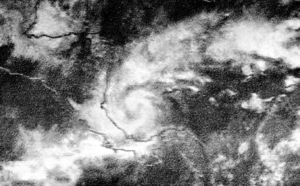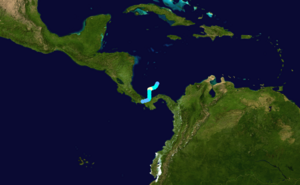Hurricane Martha facts for kids

Hurricane Martha just north of Panama on November 21
|
|
| Meteorological history | |
|---|---|
| Formed | November 21, 1969 |
| Dissipated | November 25, 1969 |
| Category 1 tropical cyclone | |
| 1-minute sustained (SSHWS/NWS) | |
| Highest winds | 90 mph (150 km/h) |
| Lowest pressure | 979 mbar (hPa); 28.91 inHg |
| Overall effects | |
| Fatalities | 5 direct |
| Damage | $30 million (1969 USD) |
| Areas affected | Panama, Costa Rica |
|
Part of the 1969 Atlantic hurricane season |
|
Hurricane Martha was a powerful storm that hit Central America in 1969. It was special because it was the only known tropical cyclone to ever make landfall in Panama. Martha was the eighteenth named storm and twelfth hurricane of the 1969 Atlantic hurricane season.
The storm started in the southwestern Caribbean Sea on November 21. It quickly grew into a hurricane. Martha reached its strongest point on November 22, with winds of 90 mph (140 km/h). After that, it got weaker and moved south. On November 24, Martha hit Veraguas Province, Panama, as a strong tropical storm. The storm then weakened and disappeared over land on November 25.
Even though the storm weakened before hitting land, it still caused a lot of rain. In Panama, some areas got over 13 inches (330 mm) of rain. This caused farms to flood in Almirante, Bocas del Toro. Streets in Puerto Armuelles, Chiriquí also flooded. Martha brought heavy rains to Costa Rica too. Flooding and mudslides cut off much of the capital city, San José. Many streets in Golfito were underwater. The storm caused about $30 million (1969 USD) in damage in Costa Rica. Sadly, 5 people also died there.
Contents
How Hurricane Martha Formed and Moved
Hurricane Martha started as a low-pressure area in the southwestern Caribbean Sea. This happened around November 20, near San Andrés, Colombia. On November 21, it officially became Tropical Storm Martha. It had winds of 50 mph (80 km/h) right away, skipping the tropical depression stage.
The storm stayed in one spot for a day. It was about 100 miles (160 km) northeast of Bocas Town, Bocas del Toro. Martha quickly grew stronger, becoming a hurricane on November 22. Later that day, a special plane flew into the storm. It found that Martha had become a strong hurricane with winds of 90 mph (140 km/h). The plane also measured the storm's lowest pressure, which was 979 mbar (28.9 inHg).
Martha's Path to Landfall
The center of the hurricane, called the eye, was about 46 miles (74 km) wide. After reaching its strongest point, Martha started moving south and slowly weakened. By November 23, it was back to being a tropical storm. Its winds had dropped to 70 mph (110 km/h).
On November 24, Martha made landfall in a rural part of Veraguas Province, Panama. This was about 10 miles (16 km) east of the Calovebora River. Martha was the only tropical cyclone known to hit Panama directly. After moving inland, the storm quickly lost power. It became a tropical depression early on November 25 and disappeared later that day.
Getting Ready and What Happened
People living near where the storm was expected to hit were warned. They were told to expect higher tides. Forecasters also warned about very heavy rainfall. They said that some areas could get more than 10 inches (250 mm) of rain. People in places like Bluefields, Nicaragua and Almirante, Panama, were told to be careful. They were warned about strong winds and heavy rain.
Impact in Panama and Costa Rica
In Panama, the storm brought at least 13 inches (330 mm) of rain to western areas. This caused a lot of flooding on farms in Almirante, Bocas del Toro. Many crops were damaged. In Puerto Armuelles, Chiriquí, the constant rain flooded streets and other low areas.
Costa Rica also experienced similar problems. The heavy rain caused widespread flooding. The capital city, San José, was flooded. The storm caused about $30 million (1969 USD) in damage in Costa Rica. Sadly, five people died in Costa Rica because of the storm.
See also
 In Spanish: Huracán Martha para niños
In Spanish: Huracán Martha para niños
- List of Category 1 Atlantic hurricanes
- Geography of Panama
- Hurricane Otto (2016) – A strong hurricane that also brought heavy rain and flooding to Panama.


